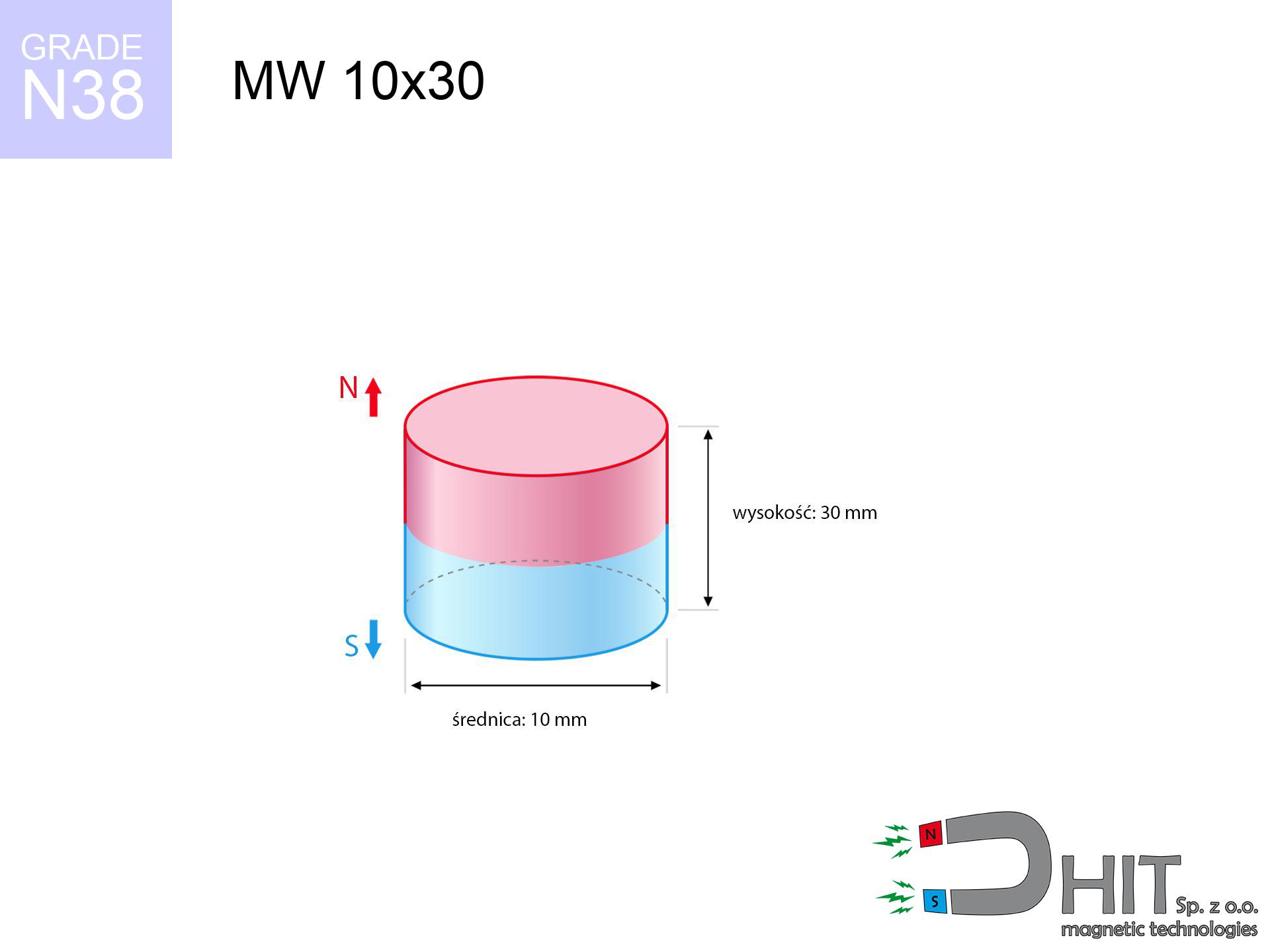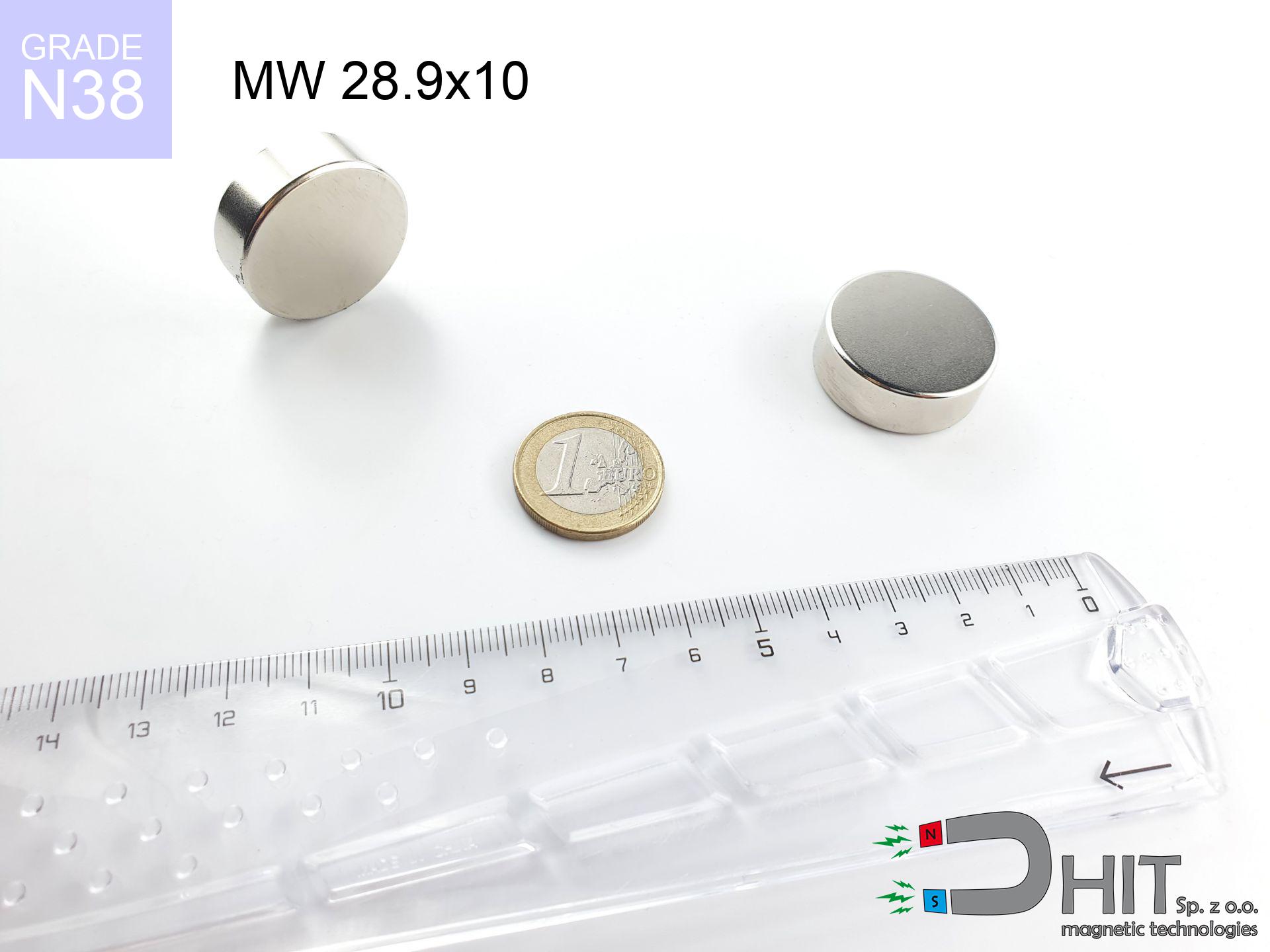MW 10x30 / N38 - cylindrical magnet
cylindrical magnet
Catalog no 010009
GTIN: 5906301810087
Diameter Ø
10 mm [±0,1 mm]
Height
30 mm [±0,1 mm]
Weight
17.67 g
Magnetization Direction
↑ axial
Load capacity
16.59 kg / 162.69 N
Magnetic Induction
610.80 mT
Coating
[NiCuNi] nickel
8.61 ZŁ with VAT / pcs + price for transport
7.00 ZŁ net + 23% VAT / pcs
bulk discounts:
Need more?Want to talk magnets?
Call us now
+48 888 99 98 98
otherwise get in touch using
form
the contact section.
Specifications and form of magnets can be reviewed on our
magnetic calculator.
Same-day processing for orders placed before 14:00.
Magnetic properties of material N38
Physical properties of sintered neodymium magnets Nd2Fe14B at 20°C
Shopping tips
Advantages as well as disadvantages of NdFeB magnets.
Besides their magnetic performance, neodymium magnets are valued for these benefits:
- They virtually do not lose strength, because even after ten years the decline in efficiency is only ~1% (according to literature),
- They show high resistance to demagnetization induced by external field influence,
- By covering with a reflective layer of gold, the element presents an professional look,
- Neodymium magnets ensure maximum magnetic induction on a their surface, which increases force concentration,
- Through (appropriate) combination of ingredients, they can achieve high thermal resistance, enabling operation at temperatures approaching 230°C and above...
- Thanks to the possibility of precise molding and adaptation to unique solutions, magnetic components can be produced in a wide range of shapes and sizes, which amplifies use scope,
- Versatile presence in modern industrial fields – they are utilized in hard drives, brushless drives, medical devices, and modern systems.
- Thanks to their power density, small magnets offer high operating force, in miniature format,
Disadvantages of NdFeB magnets:
- At strong impacts they can crack, therefore we advise placing them in special holders. A metal housing provides additional protection against damage and increases the magnet's durability.
- When exposed to high temperature, neodymium magnets experience a drop in strength. Often, when the temperature exceeds 80°C, their strength decreases (depending on the size, as well as shape of the magnet). For those who need magnets for extreme conditions, we offer [AH] versions withstanding up to 230°C
- They rust in a humid environment. For use outdoors we advise using waterproof magnets e.g. in rubber, plastic
- Due to limitations in creating threads and complicated shapes in magnets, we propose using cover - magnetic holder.
- Possible danger related to microscopic parts of magnets can be dangerous, in case of ingestion, which gains importance in the aspect of protecting the youngest. It is also worth noting that small elements of these products can complicate diagnosis medical when they are in the body.
- Higher cost of purchase is one of the disadvantages compared to ceramic magnets, especially in budget applications
Magnetic strength at its maximum – what contributes to it?
Breakaway force was determined for ideal contact conditions, assuming:
- on a base made of structural steel, perfectly concentrating the magnetic flux
- with a thickness no less than 10 mm
- with an polished contact surface
- without the slightest clearance between the magnet and steel
- under axial force direction (90-degree angle)
- at temperature approx. 20 degrees Celsius
Impact of factors on magnetic holding capacity in practice
Effective lifting capacity impacted by working environment parameters, mainly (from priority):
- Air gap (betwixt the magnet and the metal), because even a very small clearance (e.g. 0.5 mm) can cause a decrease in lifting capacity by up to 50% (this also applies to paint, corrosion or dirt).
- Pull-off angle – remember that the magnet has greatest strength perpendicularly. Under shear forces, the holding force drops significantly, often to levels of 20-30% of the maximum value.
- Base massiveness – insufficiently thick sheet does not close the flux, causing part of the flux to be escaped into the air.
- Plate material – low-carbon steel attracts best. Alloy admixtures lower magnetic permeability and lifting capacity.
- Smoothness – ideal contact is obtained only on smooth steel. Rough texture create air cushions, reducing force.
- Temperature – temperature increase causes a temporary drop of force. Check the thermal limit for a given model.
* Lifting capacity testing was carried out on plates with a smooth surface of optimal thickness, under a perpendicular pulling force, whereas under attempts to slide the magnet the load capacity is reduced by as much as 5 times. In addition, even a small distance {between} the magnet and the plate lowers the holding force.
Safe handling of neodymium magnets
Fragile material
Watch out for shards. Magnets can explode upon violent connection, launching sharp fragments into the air. Eye protection is mandatory.
Maximum temperature
Keep cool. NdFeB magnets are susceptible to heat. If you need operation above 80°C, ask us about special high-temperature series (H, SH, UH).
Adults only
Absolutely store magnets out of reach of children. Ingestion danger is significant, and the effects of magnets connecting inside the body are tragic.
Respect the power
Handle magnets consciously. Their powerful strength can surprise even professionals. Be vigilant and respect their force.
Do not drill into magnets
Machining of neodymium magnets carries a risk of fire risk. Neodymium dust reacts violently with oxygen and is difficult to extinguish.
Compass and GPS
Note: neodymium magnets generate a field that confuses precision electronics. Maintain a safe distance from your mobile, tablet, and GPS.
Serious injuries
Mind your fingers. Two powerful magnets will snap together instantly with a force of several hundred kilograms, destroying anything in their path. Be careful!
Avoid contact if allergic
A percentage of the population suffer from a hypersensitivity to nickel, which is the typical protective layer for NdFeB magnets. Extended handling may cause dermatitis. We recommend wear safety gloves.
Warning for heart patients
Patients with a pacemaker have to keep an safe separation from magnets. The magnetism can disrupt the operation of the implant.
Electronic devices
Equipment safety: Neodymium magnets can ruin data carriers and delicate electronics (pacemakers, medical aids, mechanical watches).
Security!
Details about hazards in the article: Safety of working with magnets.









